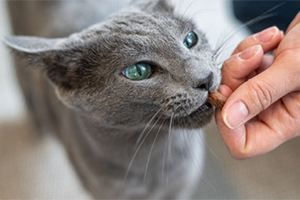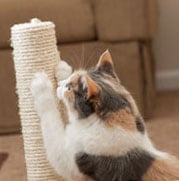Does your cat insist on jumping onto your counters, scratching your furniture or pouncing on your ankles? Our cat training tips from renowned ‘cat whisperer’ Jackson Galaxy can help change their least loveable habits for good.
Most of our cats’ habits are nothing less than adorable, but some we could probably do without! In order to discourage unwanted behaviour, says Jackson Galaxy, you’ll need to be 100% consistent in your feedback.
In the past, pet owners were sometimes advised to discourage certain feline habits by using a water squirter as a deterrent. But unless you do this every time your cat performs an unwanted action, they won’t get the message: ‘All your cat will learn is that when you’re around, they shouldn’t do something,’ he explains. Worse still, your pet might begin to associate the unpleasant consequence with your presence, rather than with their behaviours.
‘Yes/no’ theory
So how can you gently discourage a cat from doing something in the first place? According to Jackson, one solution is to remove yourself from the equation, while keeping the consequence consistent for your cat. As we’ll see, that might mean covering their favourite jumping or scratching spot with special double-sided sticky tape for a month, to reduce its appeal!
Then, you should identify what benefit your cat gets from their unwanted actions. For example, do they like receiving your attention, even if it’s negative? Jackson advises finding a way to replace this perceived benefit with a more positive solution – something he calls his ‘yes/no’ theory. Here’s how you can put his cat training tips into practice...
How to stop your cat jumping on counters
Many cat owners would love to stop their pet climbing onto kitchen counters, tables, desks or other surfaces in the home – but conveying that they’re off-limits is easier said than done!
Observe why they’re jumping up
First, assess what benefit your pet is getting out of their behaviour. ‘Are you keeping food up there, or is your cat a big fan of running water from the tap?’ asks Jackson. Keep in mind, too, that it could be a cat’s instinctive need to climb to a higher vantage point that’s driving them.
Make jumping up less rewarding
Once you’ve identified the reward in this situation, Jackson then suggests using his ‘yes/no’ theory. ‘No’ could mean making use of a consistent discouragement, such as double-sided tape. If you stick this onto your cat’s favourite jumping-up areas for at least a month, they’ll soon learn to associate these with an unpleasant tacky feeling – and avoid repeating the behaviour.
Offer a positive alternative
As Jackson notes, to effectively prevent unwanted cat behaviour you’ll need more than just a ‘no’ deterrent – you should also offer them a positive ‘yes’. For example, you could place a water fountain, or a climbing tree that’s about the same height as the counter, near the kitchen – thereby giving your cat an alternative to jumping onto your worktops.
How to stop your cat scratching furniture
Unfortunately for your household items, scratching is a natural and necessary feline behaviour. It not only allows your pet to exercise their upper body, but also helps mark out their territory.
Here’s how to encourage your cat to redirect their energies elsewhere.
Identify scratching hotspots
‘Think about where your cat is scratching,’ Jackson says. They’re likely to be making their mark on the areas where you spend the most time – such as your sofa or your bed – to complement your scent in these places with their own markings.
Say ‘no’ to scratching in those areas
Next, apply the ‘yes/no’ theory to their top scratching targets. Again, the ‘no’ in this example could mean temporarily using double-sided tape on your cat’s favourite furniture, to ensure that scratching no longer feels so satisfying.
Say ‘yes’ to scratching in the right place
‘For the “yes”, you’ll need to place a scratching post right next to the area your pet has chosen to mark,’ says Jackson. This is, after all, a spot they view as territorially important.
He recommends looking for a scratching post with a wide, secure base to help your cat feel stable while they’re running their claws down it: ‘If the post wobbles, your nice, steady sofa will automatically look more appealing.’
How to stop your cat pouncing on your ankles
Has your cat decided that your limbs are their favourite form of prey?
‘This is typical play aggression,’ Jackson explains, ‘although to your ankles it might not always feel like playing!’
Understand the behaviour
If your pet is pouncing on you unexpectedly, they’re likely to be practising their hunting skills on you. ‘This isn’t cause for concern, as at its root, this behaviour is play,’ Jackson notes.
And while it may take an unwanted form, playfulness should never be discouraged, but simply be directed into a more appropriate outlet.
Provide an alternative to your ankles
‘You’ll need to make sure you’re playing with your cat in the right way,’ Jackson says. For most cats, this will mean using an interactive toy at a level where they feel most comfortable hunting – so, low to the ground, rather than high up in the air.
You can use a variety of chase toys, such as a feather on a string or a fluffy ‘dangler’, and give your pet the thrill of stalking it by occasionally making it disappear around corners.
Set playtimes
As cats thrive on routine, establishing a set time for play every day can also help your pet feel more in control of the hunting game, and less likely to pounce at random.
‘And make sure to tire your cat out,’ says Jackson. ‘That way, you’ll help her to get rid of her energy and the tendency to pounce, how and when it suits you.’











